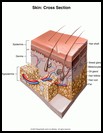
Boils (Abscesses)
What is a boil?
A boil is a tender, red lump in the skin. It is painful even when not being touched. Boils are usually 1/2 to 1 inch across.
What is the cause?
Boils are caused by a bacterial infection of a hair root or skin pore. The bacteria that cause boils are called Staphylococcus (also called staph bacteria).
How long does it last?
Without treatment, the body will fight and wall off the infection. After about a week, the center of the boil becomes soft and mushy (filled with pus). The skin over the boil then develops a pimple or becomes thin and pale. The boil is now ready for draining. Without lancing, it will drain by itself in 3 or 4 days. Until it drains, a boil can be extremely painful.
How can I take care of my child?
- Antibiotics
Boils heal faster and are less likely to recur if your child receives an antibiotic prescribed by your healthcare provider that kills staph bacteria.
- Lancing or draining the boil
Until the boil comes to a head or becomes soft, apply warm compresses 3 times a day for 20 minutes. When the boil is ready for drainage, contact your child's healthcare provider. Don’t open a boil on your own because it is a painful procedure and the pus is very contagious.
Once opened, the boil will drain pus for 2 or 3 days and then heal. Since the pus is contagious, the boil must be covered by a large 4 x 4 inch gauze bandage and tape. Change this bandage and wash the area with an antiseptic soap 2 times a day.
- Prevention of more boils
Boils can come back. The staph bacteria on the skin can be decreased by showering and washing the hair daily with an antibacterial soap. Showers are preferred because during a bath bacteria are just moved to other parts of the skin.
- Contagiousness
The pus in boils is contagious. Make sure that other people in your family do not use your child's towel or washcloth. Wash any clothes, towels, or sheets that are contaminated with drainage from the boils with Lysol. Any bandages with pus on them should be carefully thrown away.
- Common mistakes in the treatment of boils
Sometimes friends or relatives may advise you to squeeze a boil until you get the core out. The pus in a boil will come out easily if the opening is large enough. Squeezing is not only very painful but also carries the risk that bacteria will be forced into the bloodstream. Squeezing can also cause other boils in the same area. Squeezing boils on the face is especially dangerous.
When should I call my child's healthcare provider?
Call during office hours if:
- The boil is not better within 48 hours after starting the antibiotic.
- The skin around the boil turns red or red streaks appear.
- The boil has come to a head and needs to be opened.
- You have other concerns or questions.

